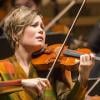
The late, much-lamented British composer/conductor Oliver Knussen merited not one, but two tribute concerts — a minifestival, if you will. While the first concert over the past weekend (reviewed by Jim Farber) touched upon large-scale Knussen — in terms of ensemble size, not timespan — the second program at Walt Disney Concert Hall Tuesday night (Dec. 10) dealt with Knussen for smaller ensembles, juxtaposed with works by some of his British friends, colleagues, and students.
For Knussen, once a frequent guest on the Los Angeles Philharmonic’s Green Umbrella new-music series, it was a homecoming in absentia as cocurated by conductor Susanna Mälkki and violinist/Knussen champion Leila Josefowicz. In the process, the announced order of the program was virtually flipped on its head by concert time, and it made a lot more sense that way.

Rather than bury Knussen’s festive Two Organa toward the end of the evening, Mälkki and 21 players from the LA Phil New Music Group led off with it, its sparkling, glittering instrumentation exploding with welcome-to-the-show color in the Disney Hall acoustics. Another Knussen miniature, Ophelia Dances Book I, a color-drenched kaleidoscope of sound for nine instruments with a lurching dance rhythm in the center, gracefully conducted by Mälkki, was moved toward the front of the program.

Knussen’s Reflection, from 2016, one of the last pieces he was able to finish, now came second from the end. A duo for violin and piano, Reflection poses a series of questioning lines at first, then moves through various stages of repose and intensity, closing in uncharacteristically anguished high emotion (many, if not most, Knussen pieces tend to end quietly). Josefowicz played it brilliantly from memory, with John Novacek on piano.
Instead of opening the program with Colin Matthews’s Hidden Variables, which was the most expansive work of the evening (if not by much), Mälkki moved it to the last slot. A marvelous, action-packed piece, Hidden Variables was a good choice with which to sum things up, as well as to add a few developments not touched upon before — like Philip Glassian repetitions and voicings that must be one of the styles that Matthews good-naturedly refers to as “more fashionable than others (including my own).”
The program also featured works by younger composers who came under the Knussen influence. A lot happens in Huw Watkins’s Piano Quartet in just under 10 minutes — pastoral music that turns dissonant and agitated in the center, going through several such changes until the piece ends quietly. Helen Grime’s A Cold Spring for 10 instruments in three continuous parts produced a thicket of sound illuminated by harp at first, with a short, contemplative concerto for slightly harsh-sounding French horn in the center.

What’s interesting and telling about all of the ensemble pieces by these four composers is that they share a similar general profile. There is a profusion of color wrought from minimal means in textures of uncertain tonality or dissonance, usually packing a lot of mood changes into concentrated containers between five and 13 minutes in length. Much of the evening felt like a gathering of a specific British new-music circle.
The most obvious outlier was an electronic tape piece by IRCAM (Institute for Research and Coordination in Acoustics/Music) alumnus Jonathan Harvey, Mortuos Plango, Vivos Voco, that opened the second half instead of closing the concert. The piece is supposed to reflect the composer’s experiences at Winchester Cathedral (anyone remember the New Vaudeville Band’s fluke hit song of that name from 1966?), with the voice of Harvey’s son, atmospheric swoops of electronics, and ultimately the bonging of the cathedral’s big, black, tenor bell. It’s a haunting tape in a mostly older style of electronic music, and the tolling conclusion could serve as a minirequiem for Knussen in this context.




